The Resilience of the Built Environment to Flooding: The Case of Alappuzha District in the South Indian State of Kerala
Abstract
:1. Introduction
2. Literature Review
2.1. Engineering Resilience and Ecological Resilience
2.2. Resilience and Sustainability Paradox
2.3. Flood Resilience Approaches in the Built Environment
2.4. The Built Environment and Flooding
3. Materials and Methods
3.1. The Research Design
3.2. The Case Study Setting: Alappuzha District in the South Indian State of Kerala
4. Results and Discussion
4.1. Alappuzha: Flood Vulnerability and Built Environment
4.2. Traditional Keralan Architecture and Flood Resilience
4.3. Flood Resilience Approaches in Kerala
- Structural and practical limitations: Raising houses (sometimes even up to 12–15 feet) above the street resolves the issue of flooding but makes accessibility to living areas difficult and makes everyday life inconvenient. Elevating buildings in such areas also makes them vulnerable to wind.
- Loss of neighbourhood character: Transformations to permanently elevated houses deprive neighbourhoods of all their historic urban character. Such an approach will also affect how communities and people connect.
- Increasing the width and stability of stilts can enhance their structural stability, but it also increases construction costs, potentially making them unaffordable for most residents. Most importantly, English [34] pointed out that any fixed elevation will not ensure full floodproofing, which makes the entire effort to elevate unworthy. In the predominantly agrarian communities of Alappuzha, people have strong connections with land and water, as shown in Figure 15. Residents are not confined to the boundaries of their homes but, rather, interact with the immediate outdoor environment for their daily tasks. As a result, permanently elevating houses owing to the risk of floods may not be the optimal decision.
5. Conclusions
6. Limitations
7. Contribution to Knowledge
Author Contributions
Funding
Institutional Review Board Statement
Informed Consent Statement
Data Availability Statement
Conflicts of Interest
References
- Bektaş, Y.; Sakarya, A. The Relationship between the Built Environment and Climate Change: The Case of Turkish Provinces. Sustainability 2023, 15, 1659. [Google Scholar] [CrossRef]
- World Bank. Kerala Partnership Breaks New Ground in Mainstreaming Adaptation to Climate Change. Available online: https://www.worldbank.org/en/country/india/brief/world-bank-kerala-state-partnership-breaks-new-ground-in-sub-national-strategic-engagement (accessed on 22 January 2024).
- Chao-Amonphat, S.; Nitivattananon, V.; Srinonil, S. Adaptation Measures on Hydrological Risks and Climate Change Impacts in Urbanized Sub-Region, Thailand: A Case Study in Lower Chao Phraya River Basin. Int. J. Disaster Resil. Built Environ. 2024, 15, 59–79. [Google Scholar] [CrossRef]
- Ariyaningsih; Sukhwani, V.; Shaw, R. Vulnerability Assessment of Balikpapan (Indonesia) for Climate Change-Induced Urban Flooding. Int. J. Disaster Resil. Built Environ. 2023, 14, 387–401. [Google Scholar] [CrossRef]
- Tahir, F.; Madandola, M.G.; Al-Ghamdi, S.G. Enhancing Resilience: Surveillance Strategies for Monitoring the Spread of Vector-Borne Diseases. In Sustainable Cities in a Changing Climate; John and Wiley and Sons: Hoboken, NJ, USA, 2024; pp. 263–276. [Google Scholar]
- Sharifi, A. Flood Mapping Using Relevance Vector Machine and SAR Data: A Case Study from Aqqala, Iran. J. Indian Soc. Remote Sens. 2020, 48, 1289–1296. [Google Scholar] [CrossRef]
- Fahad, S.; Hossain, M.S.; Huong, N.T.L.; Nassani, A.A.; Haffar, M.; Naeem, M.R. An Assessment of Rural Household Vulnerability and Resilience in Natural Hazards: Evidence from Flood Prone Areas. Environ. Dev. Sustain. 2023, 25, 5561–5577. [Google Scholar] [CrossRef]
- Sarıcıoğlu, P.; Ayçam, İ. Building Design in the Context of Climate Change and a Flood Projection for Ankara. In Adapting the Built Environment for Climate Change; Elsevier: Amsterdam, The Netherlands, 2023; pp. 327–347. [Google Scholar]
- Chmutina, K.; Lizarralde, G.; von Meding, J.; Bosher, L. Standardised Indicators for “Resilient Cities”: The Folly of Devising a Technical Solution to a Political Problem. Int. J. Disaster Resil. Built Environ. 2023, 14, 514–535. [Google Scholar] [CrossRef]
- Adegun, O.B. Flood-Related Challenges and Impacts within Coastal Informal Settlements: A Case from LAGOS, NIGERIA. Int. J. Urban Sustain. Dev. 2023, 15, 1–13. [Google Scholar] [CrossRef]
- Islam, A.; Shit, P.K.; Datta, D.K.; Islam, M.S.; Roy, S.; Ghosh, S.; Das, B.C. Floods in the Ganga–Brahmaputra–Meghna Delta; Springer International Publishing: Cham, Switzerland, 2023; ISBN 978-3-031-21085-3. [Google Scholar]
- Bernardini, G.; Ferreira, T.M.; Baquedano Julià, P.; Ramírez Eudave, R.; Quagliarini, E. Assessing the Spatiotemporal Impact of Users’ Exposure and Vulnerability to Flood Risk in Urban Built Environments. Sustain. Cities Soc. 2024, 100, 105043. [Google Scholar] [CrossRef]
- Felsenstein, D.; Lichter, M. Social and Economic Vulnerability of Coastal Communities to Sea-Level Rise and Extreme Flooding. Nat. Hazards 2014, 71, 463–491. [Google Scholar] [CrossRef]
- Bukvic, A.; Barnett, S. Drivers of Flood-Induced Relocation among Coastal Urban Residents: Insight from the US East Coast. J. Environ. Manag. 2023, 325, 116429. [Google Scholar] [CrossRef]
- Kuru, O.D.; Ganapati, N.E.; Marr, M. Perceptions of Local Leaders Regarding Postdisaster Relocation of Residents in the Face of Rising Seas. Hous. Policy Debate 2023, 33, 1124–1145. [Google Scholar] [CrossRef]
- Krishnakumar, K.N.; Prasada Rao, G.S.L.H.V.; Gopakumar, C.S. Rainfall Trends in Twentieth Century over Kerala, India. Atmos. Environ. 2009, 43, 1940–1944. [Google Scholar] [CrossRef]
- Vijaykumar, P.; Abhilash, S.; Sreenath, A.V.; Athira, U.N.; Mohanakumar, K.; Mapes, B.E.; Chakrapani, B.; Sahai, A.K.; Niyas, T.N.; Sreejith, O.P. Kerala Floods in Consecutive Years—Its Association with Mesoscale Cloudburst and Structural Changes in Monsoon Clouds over the West Coast of India. Weather Clim. Extrem. 2021, 33, 100339. [Google Scholar] [CrossRef]
- Chithra, K.; Binoy, B.V.; Bimal, P. Spatial Mapping of the Flood-Affected Regions of Northern Kerala: A Case Study of 2018 Kerala Floods. J. Indian Soc. Remote Sens. 2022, 50, 677–688. [Google Scholar] [CrossRef]
- Archer, R.; Choi, H.; Vasconez, R.; Najm, H.; Gong, J. Adaptive Coastal Construction: Designing Amphibious Homes to Resist Hurricane Winds and Storm Surges. J. Ocean Eng. Mar. Energy 2023, 9, 273–290. [Google Scholar] [CrossRef]
- English, E.C.; Chen, M.; Zarins, R.; Patange, P.; Wiser, J.C. Building Resilience through Flood Risk Reduction: The Benefits of Amphibious Foundation Retrofits to Heritage Structures. Int. J. Archit. Herit. 2021, 15, 976–984. [Google Scholar] [CrossRef]
- Ameh, H.; Badarnah, L.; Lamond, J. Amphibious Architecture: A Biomimetic Design Approach to Flood Resilience. Sustainability 2024, 16, 1069. [Google Scholar] [CrossRef]
- Marlow, E.C.; Chmutina, K.; Dainty, A. Interpreting Sustainability and Resilience in the Built Environment. Int. J. Disaster Resil. Built Environ. 2023, 14, 332–348. [Google Scholar] [CrossRef]
- Wisner, B. Five Years Beyond Sendai—Can We Get Beyond Frameworks? Int. J. Disaster Risk Sci. 2020, 11, 239–249. [Google Scholar] [CrossRef]
- UNISDR. How To Make Cities More Resilient A Handbook For Local Government Leaders A Contribution to the Global Campaign 2010–2020 Making Cities Resilient—“My City Is Getting Ready!”; UNISDR: Geneva, Switzerland, 2017. [Google Scholar]
- The Rockefeller Foundation and Arup. City Resilience Framework; The Rockefeller Foundation and Arup: London, UK, 2015. [Google Scholar]
- Holling, C.S. Resilience and Stability of Ecological Systems. Annu. Rev. Ecol. Syst. 1973, 4, 1–23. [Google Scholar] [CrossRef]
- Meerow, S.; Newell, J.P. Urban Resilience for Whom, What, When, Where, and Why? In Geographic Perspectives on Urban Sustainability; Routledge: London, UK, 2021; pp. 43–63. [Google Scholar]
- Amirzadeh, M.; Sobhaninia, S.; Sharifi, A. Urban Resilience: A Vague or an Evolutionary Concept? Sustain. Cities Soc. 2022, 81, 103853. [Google Scholar] [CrossRef]
- Bush, J.; Doyon, A. Building Urban Resilience with Nature-Based Solutions: How Can Urban Planning Contribute? Cities 2019, 95, 102483. [Google Scholar] [CrossRef]
- Davoudi, S. Resilience: A Bridging Concept or a Dead End? Plan. Theory Pract. 2012, 13, 299–333. [Google Scholar] [CrossRef]
- Major, M.D.; Al-Nabet, S.F. Building’s Don’t Bounce: The Design Paradox of Urban Resilience. In Proceedings of the 26th Annual Congress for The New Urbanism, Savannah, GA, USA, 16 May 2018; pp. 1–10. [Google Scholar]
- UNDRR. Global Assessment Report on Disaster Risk Reduction 2019; UNISDR: Geneva, Switzerland, 2019; ISBN 9789210041805. [Google Scholar]
- Matczak, P.; Hegger, D. Improving Flood Resilience through Governance Strategies: Gauging the State of the Art. WIREs Water 2021, 8, e1532. [Google Scholar] [CrossRef]
- English, E.C. Amphibious Foundations and the Buoyant Foundation Project: Innovative Strategies for Flood Resilient Housing. In Proceedings of the International Conference on Urban Flood Management, Paris, France, 25–27 November 2009; pp. 1–8. [Google Scholar]
- Topsider Hurricane Homes. Available online: https://www.topsiderhomes.com/hurricane-proof-homes.php (accessed on 3 March 2024).
- Prosun, P. LIFT House: An Amphibious Strategy for Sustainable and Affordable Housing for the Urban Poor in Flood-Prone Bangladesh. Ph.D. Thesis, University of Waterloo, Waterloo, ON, Canada, 2011. [Google Scholar]
- Moon, C. A Study on the Floating House for New Resilient Living. J. Korean Hous. Assoc. 2015, 26, 97–104. [Google Scholar] [CrossRef]
- Piatek, Ł.; Wojnowska-Heciak, M. Multicase Study Comparison of Different Types of Flood-Resilient Buildings (Elevated, Amphibious, and Floating) at the Vistula River in Warsaw, Poland. Sustainability 2020, 12, 9725. [Google Scholar] [CrossRef]
- Brody, S.D.; Zahran, S.; Maghelal, P.; Grover, H.; Highfield, W.E. The Rising Costs of Floods: Examining the Impact of Planning and Development Decisions on Property Damage in Florida. J. Am. Plan. Assoc. 2007, 73, 330–345. [Google Scholar] [CrossRef]
- Bin, L.; Xu, K.; Pan, H.; Zhuang, Y.; Shen, R. Urban Flood Risk Assessment Characterizing the Relationship among Hazard, Exposure, and Vulnerability. Environ. Sci. Pollut. Res. 2023, 30, 86463–86477. [Google Scholar] [CrossRef] [PubMed]
- Zhao, H.; Gu, T.; Tang, J.; Gong, Z.; Zhao, P. Urban Flood Risk Differentiation under Land Use Scenario Simulation. iScience 2023, 26, 106479. [Google Scholar] [CrossRef]
- Idowu, D.; Zhou, W. Global Megacities and Frequent Floods: Correlation between Urban Expansion Patterns and Urban Flood Hazards. Sustainability 2023, 15, 2514. [Google Scholar] [CrossRef]
- Seemuangngam, A.; Lin, H.-L. The Impact of Urbanization on Urban Flood Risk of Nakhon Ratchasima, Thailand. Appl. Geogr. 2024, 162, 103152. [Google Scholar] [CrossRef]
- Yang, Q.; Zhang, S.; Dai, Q.; Yao, R. Assessment of Community Vulnerability to Different Types of Urban Floods: A Case for Lishui City, China. Sustainability 2020, 12, 7865. [Google Scholar] [CrossRef]
- Tempa, K. District Flood Vulnerability Assessment Using Analytic Hierarchy Process (AHP) with Historical Flood Events in Bhutan. PLoS ONE 2022, 17, e0270467. [Google Scholar] [CrossRef] [PubMed]
- Manandhar, B.; Cui, S.; Wang, L.; Shrestha, S. Urban Flood Hazard Assessment and Management Practices in South Asia: A Review. Land 2023, 12, 627. [Google Scholar] [CrossRef]
- Zhou, Y.; She, D.; Wang, Y.; Xia, J.; Zhang, Y. Evaluating the Impact of Low Impact Development Practices on the Urban Flooding over a Humid Region of China. JAWRA J. Am. Water Resour. Assoc. 2022, 58, 1264–1278. [Google Scholar] [CrossRef]
- Huang, Y.; Lin, J.; He, X.; Lin, Z.; Wu, Z.; Zhang, X. Assessing the Scale Effect of Urban Vertical Patterns on Urban Waterlogging: An Empirical Study in Shenzhen. Environ. Impact Assess. Rev. 2024, 106, 107486. [Google Scholar] [CrossRef]
- Zhang, D.; Shi, X.; Xu, H.; Jing, Q.; Pan, X.; Liu, T.; Wang, H.; Hou, H. A GIS-Based Spatial Multi-Index Model for Flood Risk Assessment in the Yangtze River Basin, China. Environ. Impact Assess. Rev. 2020, 83, 106397. [Google Scholar] [CrossRef]
- Van Coppenolle, R.; Temmerman, S. Identifying Global Hotspots Where Coastal Wetland Conservation Can Contribute to Nature-Based Mitigation of Coastal Flood Risks. Glob. Planet. Chang. 2020, 187, 103125. [Google Scholar] [CrossRef]
- Berde, V.B.; Chari, P.V.B.; Berde, C.V. Wetland and Biodiversity Hotspot Conservation. In Research Anthology on Ecosystem Conservation and Preserving Biodiversity; IGI Global: Hershey, PA, USA, 2022; pp. 775–784. [Google Scholar]
- Acreman, M.; Holden, J. How Wetlands Affect Floods. Wetlands 2013, 33, 773–786. [Google Scholar] [CrossRef]
- Ming, J.; Xian-guo, L.; Lin-shu, X.; Li-juan, C.; Shouzheng, T. Flood Mitigation Benefit of Wetland Soil—A Case Study in Momoge National Nature Reserve in China. Ecol. Econ. 2007, 61, 217–223. [Google Scholar] [CrossRef]
- Ramachandra, T.V.; Karthick, B.; Boominathan, M.; Ali, A.; Avinash, K.G. Waterscape of Kerala—Characterisation of Surface, Well and Tap Water in All Districts; CES Technical Report 133; Indian Institute of Science: Bangalore, India, 2013. [Google Scholar]
- Indian Ministry of Housing and Urban Affairs. Urbanization in Indian States. Available online: https://mohua.gov.in/cms/level-of-urbanisation.php (accessed on 1 June 2023).
- Government of India. Census of India. Available online: https://censusindia.gov.in/census.website/data/population-finder (accessed on 24 February 2023).
- Kerala State Planning Board. Kerala Development Report: Initiatives, Achievements, and Challenges; Kerala State Planning Board: Thiruvananthapuram, Kerala, 2021.
- The Irrigation Design and Research Board (IDRB) Irrigation Department, Government of Kerala. Available online: https://irrigation.kerala.gov.in/river-basin (accessed on 4 March 2024).
- Department Of Town And Country Planning—Government Of Kerala. District Urbanization Report—Alappuzha; Department Of Town And Country Planning—Government Of Kerala: Kannur, India, 2011.
- Jose, A.V. Building a New Kerala: Ideas and Reflections RULSG-Policy Pointers Series: 9 Some Priorities for Rehabilitation in the Kuttanad Region; Centre for Development Studies (JNU): Thiruvananthapuram, India, 2018. [Google Scholar]
- Jacinth Jennifer, J.; Saravanan, S.; Abijith, D. Integration of SAR and Multi-Spectral Imagery in Flood Inundation Mapping–a Case Study on Kerala Floods 2018. ISH J. Hydraul. Eng. 2020, 28, 480–490. [Google Scholar] [CrossRef]
- Walia, A.; Sharma, P.; Nusrat, N. Kerala Floods 2018: Impacts and Lessons Drawn. In International Handbook of Disaster Research; Springer: Berlin/Heidelberg, Germany, 2022; pp. 1–17. [Google Scholar]
- Balbi, S.; Villa, F.; Mojtahed, V.; Hegetschweiler, K.T.; Giupponi, C. A Spatial Bayesian Network Model to Assess the Benefits of Early Warning for Urban Flood Risk to People. Nat. Hazards Earth Syst. Sci. 2016, 16, 1323–1337. [Google Scholar] [CrossRef]
- Tiwari, V.; Kumar, V.; Matin, M.A.; Thapa, A.; Ellenburg, W.L.; Gupta, N.; Thapa, S. Flood Inundation Mapping-Kerala 2018; Harnessing the Power of SAR, Automatic Threshold Detection Method and Google Earth Engine. PLoS ONE 2020, 15, e0237324. [Google Scholar] [CrossRef] [PubMed]
- Roy, C.M.; Manoj, E.; Joy, H.; Ravi, S.; Roy, A. Development of Flood Hazard Vulnerability Map for Alappuzha District. Int. J. Curr. Eng. Sci. Res. 2018, 5, 77–81. [Google Scholar]
- Government of Kerala. Demography (As Per Provisional Population Figures of 2011 Census). Available online: https://alappuzha.nic.in/en/demography/ (accessed on 17 April 2023).
- Valdeolmillos, N.A.A.; Furlan, R.; Tadi, M.; Sinclair, B.R.; Awwaad, R. Towards a Knowledge-Hub Destination: Analysis and Recommendation for Implementing TOD for Qatar National Library Metro Station. Environ. Dev. Sustain. 2023, 26, 9783–9815. [Google Scholar] [CrossRef]
- Jacob Jikku Varghese Satellite Images, App to Aid Estimate of Kerala Flood Loss. Available online: https://www.onmanorama.com/news/kerala/2018/08/28/satellite-images-app-aid-estimate-kerala-flood-loss.html (accessed on 2 January 2024).
- Venkitasubramanian, S. Floods in Kerala. Available online: https://www.reuters.com/news/picture/floods-in-kerala-idINRTS1XFOF/ (accessed on 7 September 2023).
- Dauphin, L. Before and After the Kerala Floods. Available online: https://earthobservatory.nasa.gov/images/92669/before-and-after-the-kerala-floods (accessed on 4 March 2024).
- Koduveliparambil, J.J. Construction Practices in Traditional Dwellings of Kerala, India. Master’s Thesis, McGill University, Montreal, QC, Canada, 1997. [Google Scholar]
- Kuriakose, B. Evolution of Kerala Architecture Over the Years. Available online: https://www.bennykuriakose.com/post/evolution-of-kerala-architecture-over-the-years (accessed on 31 May 2023).
- Prakash, B.A. Gulf Migration and Its Economic Impact: The Kerala Experience. Econ. Polit. Wkly. 1998, 33, 3209–3213. [Google Scholar]
- Mukherji, R. Introduction: Globalization and Change in India. India Rev. 2019, 18, 1–7. [Google Scholar] [CrossRef]
- Al-Mohannadi, M.; Awwaad, R.; Furlan, R.; Grosvald, M.; Al-Matwi, R.; Isaifan, R.J. Sustainable Status Assessment of the Transit-Oriented Development in Doha’s Education City. Sustainability 2023, 15, 1913. [Google Scholar] [CrossRef]
- Singh, A.K.; Sharma, P.; Krishnaraj, L.; Prasath Kumar, V.R. Design and Analysis of Flood Resisting Residential Building: A Case Study in Malappuram-KERALA. J. Eng. Res. 2022, 9, 1–12. [Google Scholar] [CrossRef]
- Neeraj, S.; Mannakkara, S.; Wilkinson, S. Build Back Better Concepts for Resilient Recovery: A Case Study of India’s 2018 Flood Recovery. Int. J. Disaster Resil. Built Environ. 2020, 12, 280–294. [Google Scholar] [CrossRef]
- Philip, S. Kerala: 2018 Flood on Mind, Houses in Backwaters Region Now on Stilts. Available online: https://indianexpress.com/article/india/kerala-2018-flood-on-mind-houses-in-backwaters-region-now-on-stilts-6484055/ (accessed on 14 April 2023).
- Kerala House Lifting Services. Available online: https://keralahouselifting.com/ (accessed on 29 February 2024).
- Footloose Dev. Life in the Backwaters of Alleppey, Kerala. Available online: https://footloosedev.com/life-in-the-backwaters-of-alleppey-kerala/ (accessed on 1 March 2023).
- Furlan, R.; Grosvald, M.; Azad, A. A Social-Ecological Perspective for Emerging Cities: The Case of Corniche Promenade, “Urban Majlis” of Doha. J. Infrastruct. Policy Dev. 2022, 6, 1496. [Google Scholar] [CrossRef]
- Pramanik, A.; Sujay, P.; Alex, A.M. Capacity Building for Early Warning System (Kavalam Panchayat, Kuttanad Taluk, Alappuzha District, Kerala); Tata Insititute of Social Sciences: Mumbai, India, 2019. [Google Scholar]
- Dutta, M. Disaster Risk Reduction and Resilience Building Among the Coastal Zone Communities in Lakshwadeep and Kerala. In Disaster Risk Reduction: Community Resilience and Responses; Bupinder, Z., Ahmad, A., Srungarapati, A.B., Eds.; Springer Nature: Singapore, 2019; pp. 279–297. ISBN 978-981-10-8845-2. [Google Scholar]
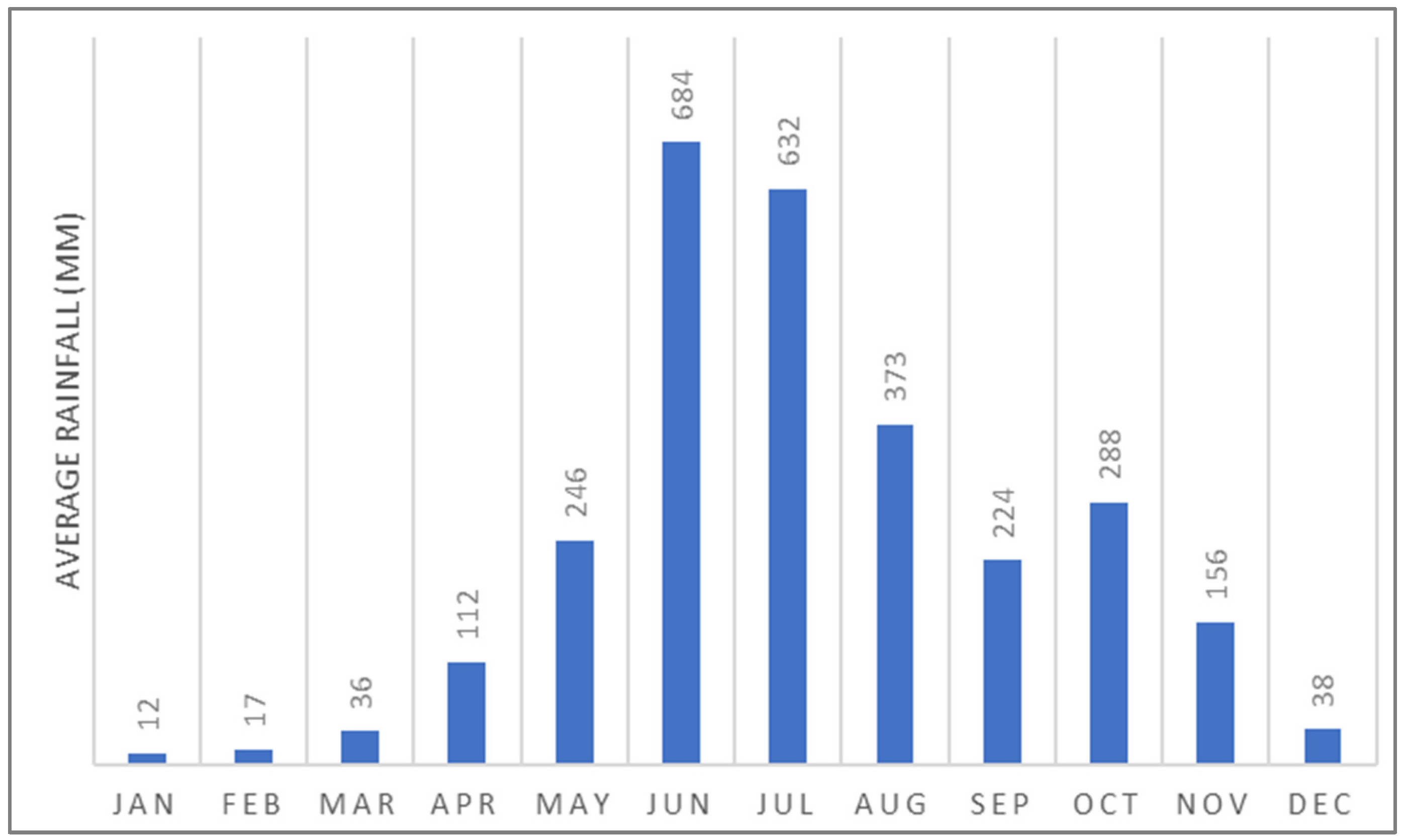
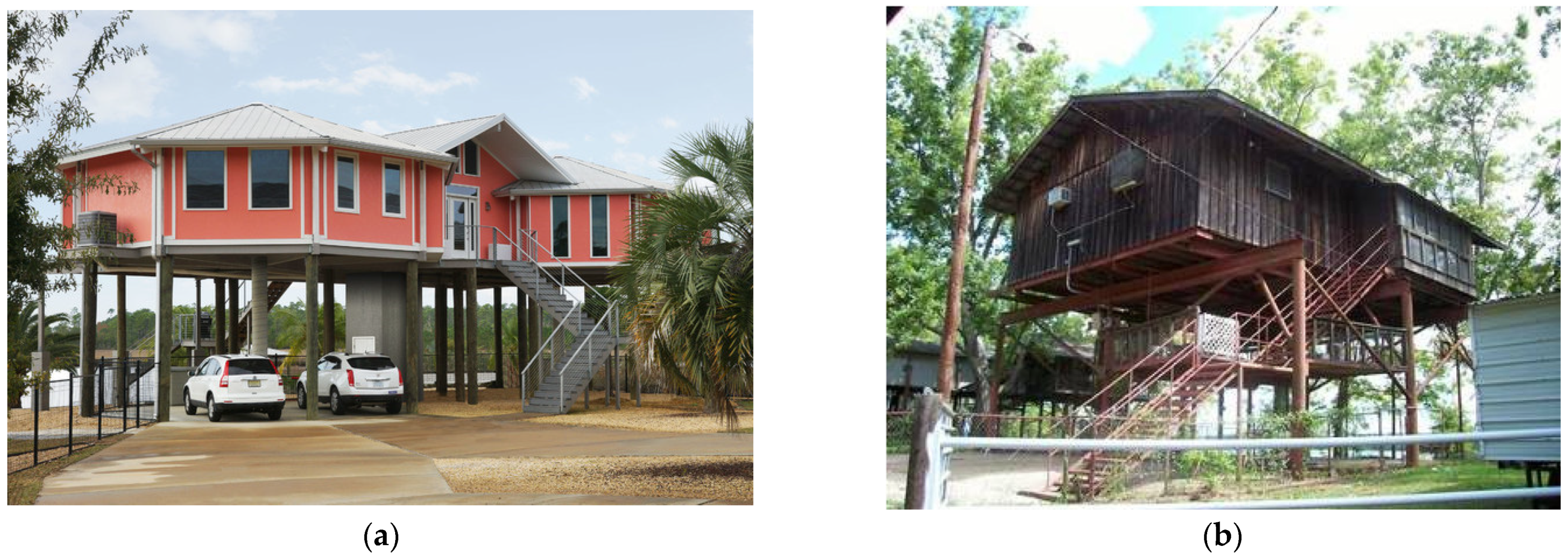


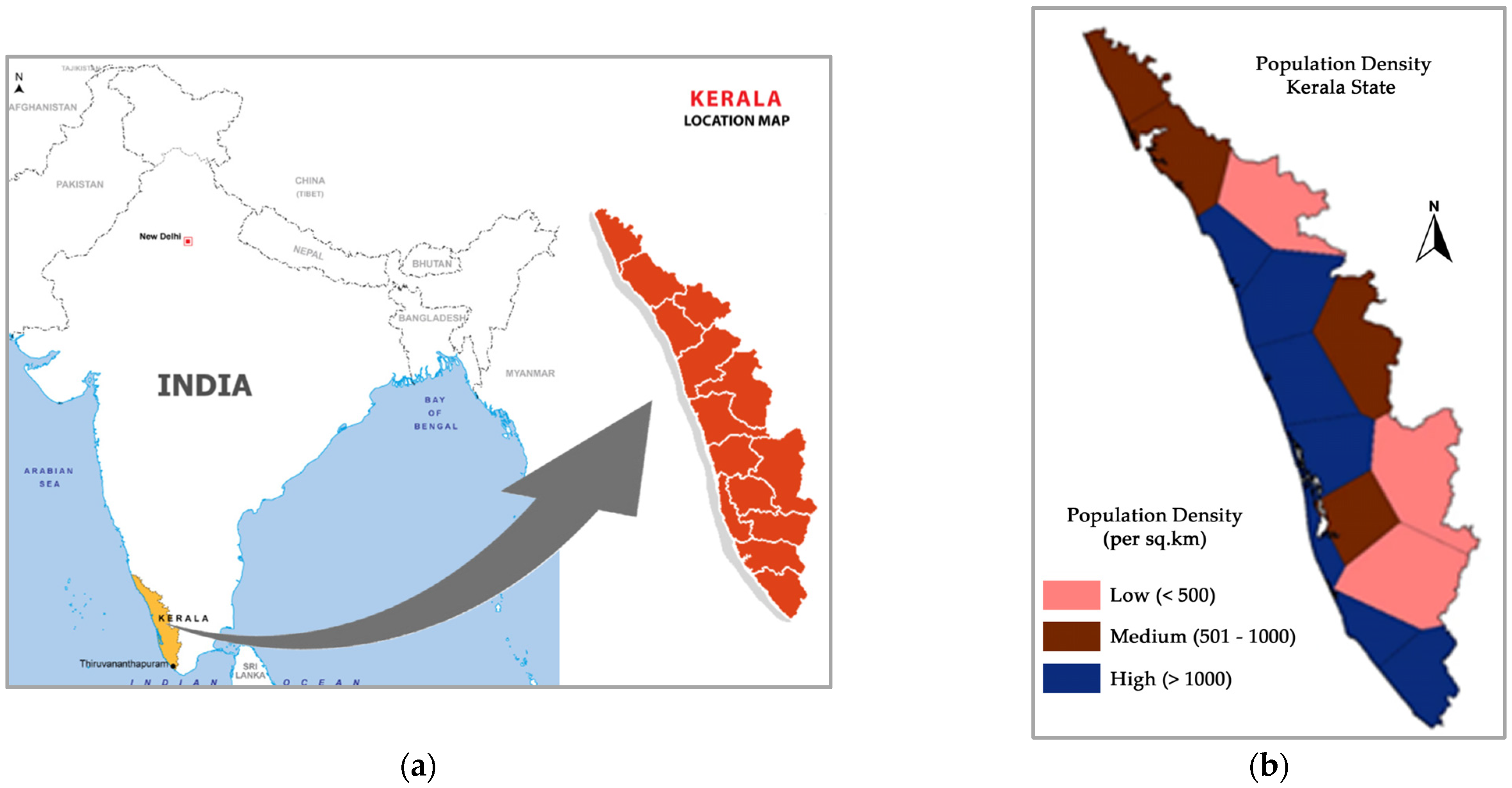

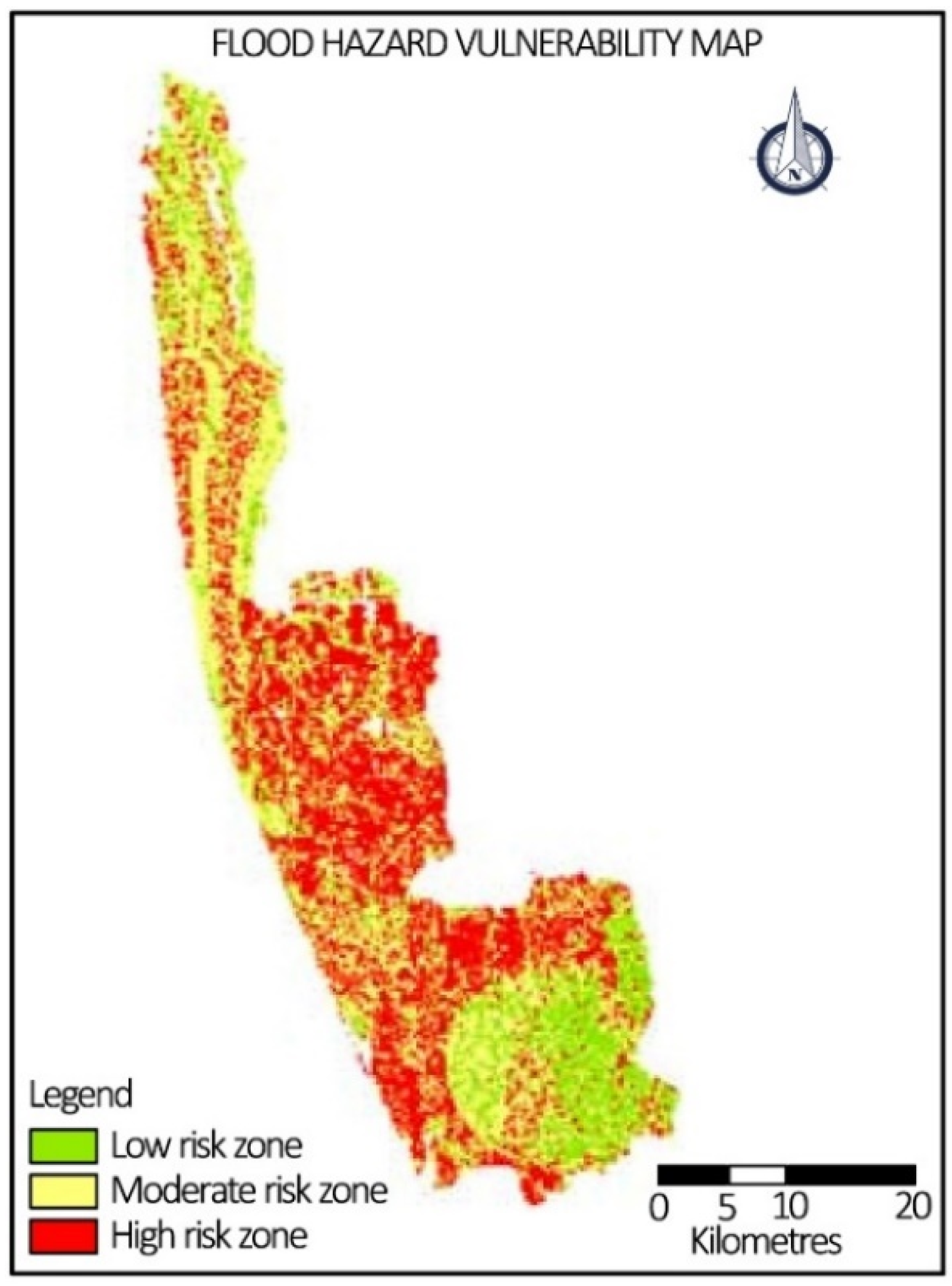
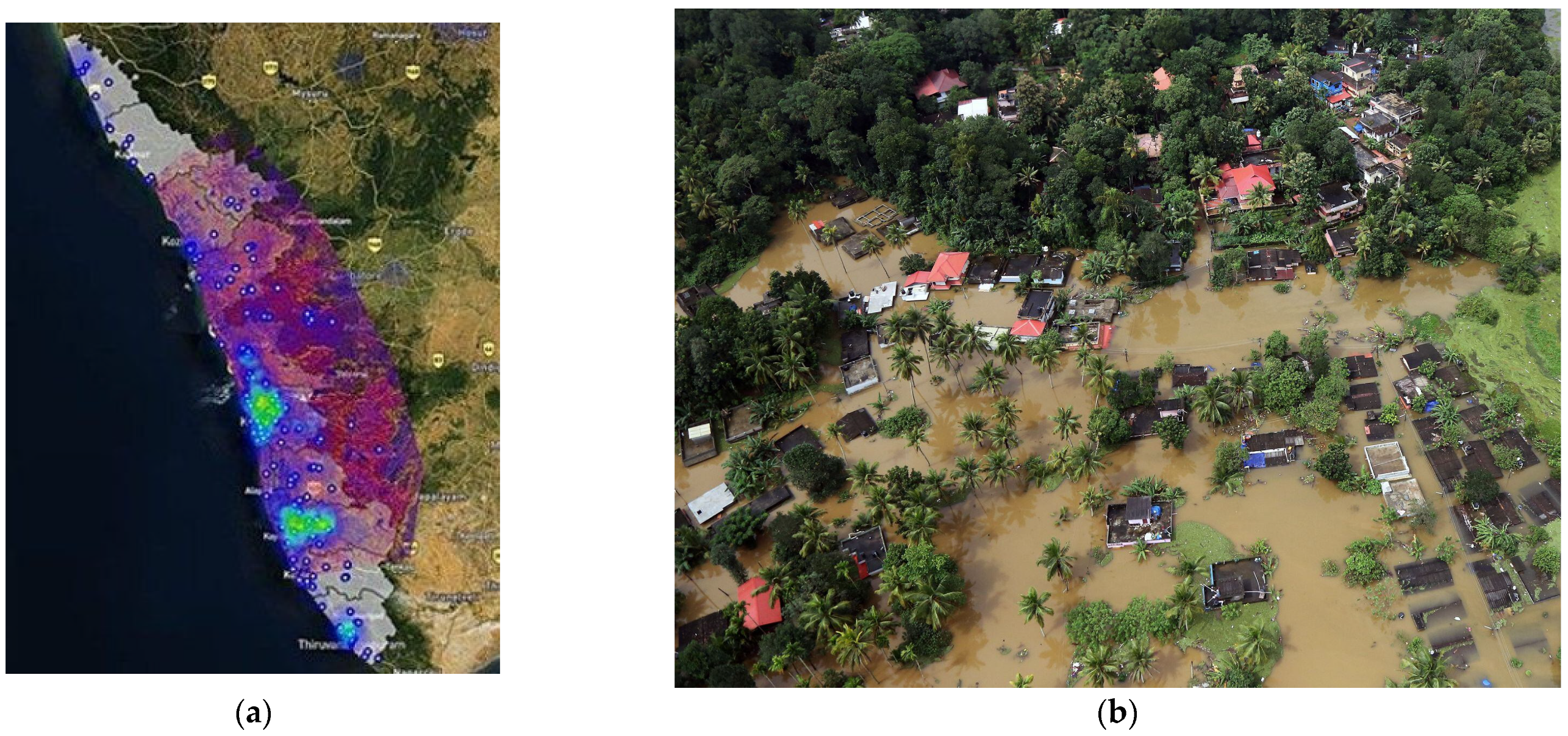
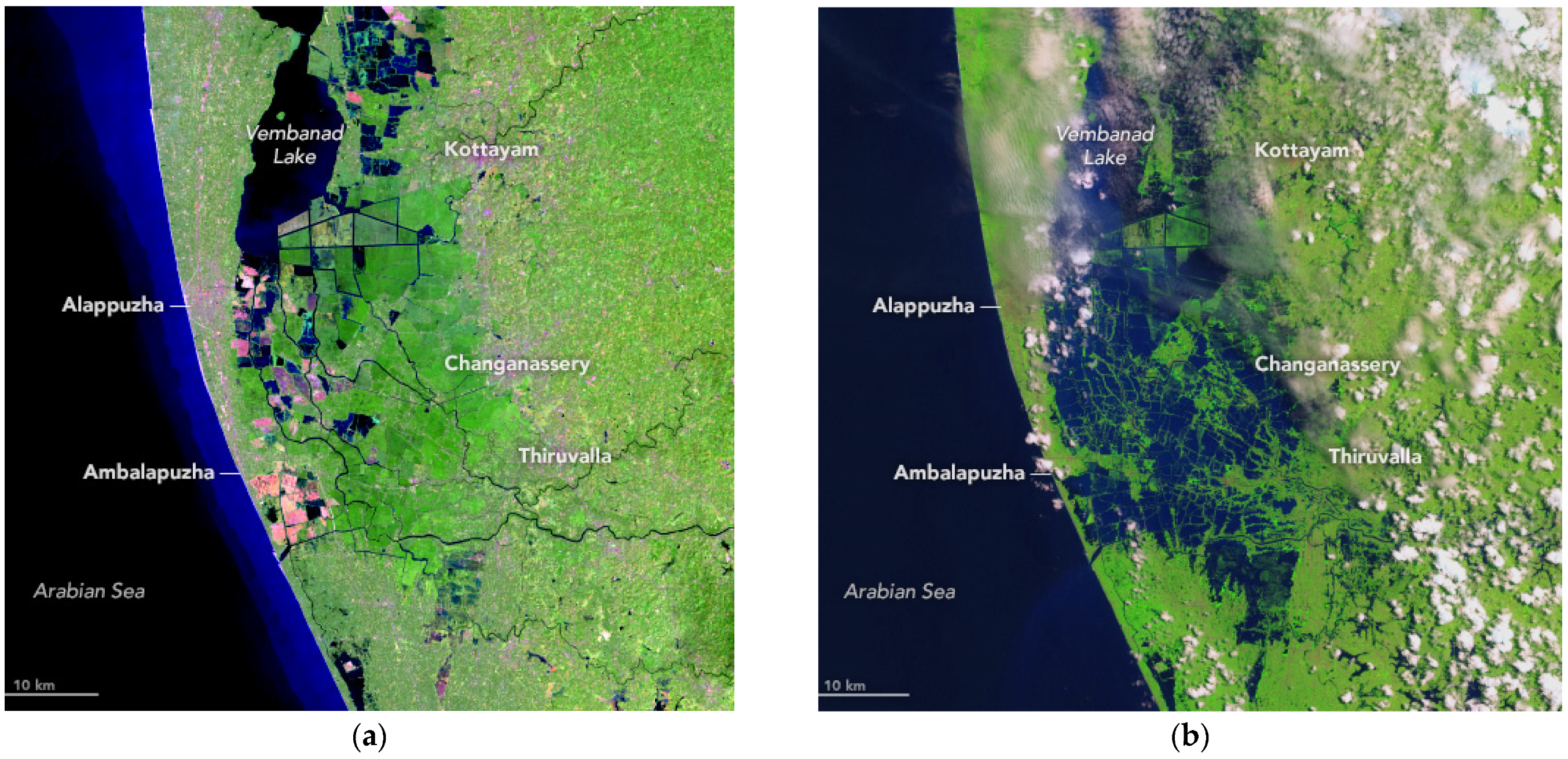
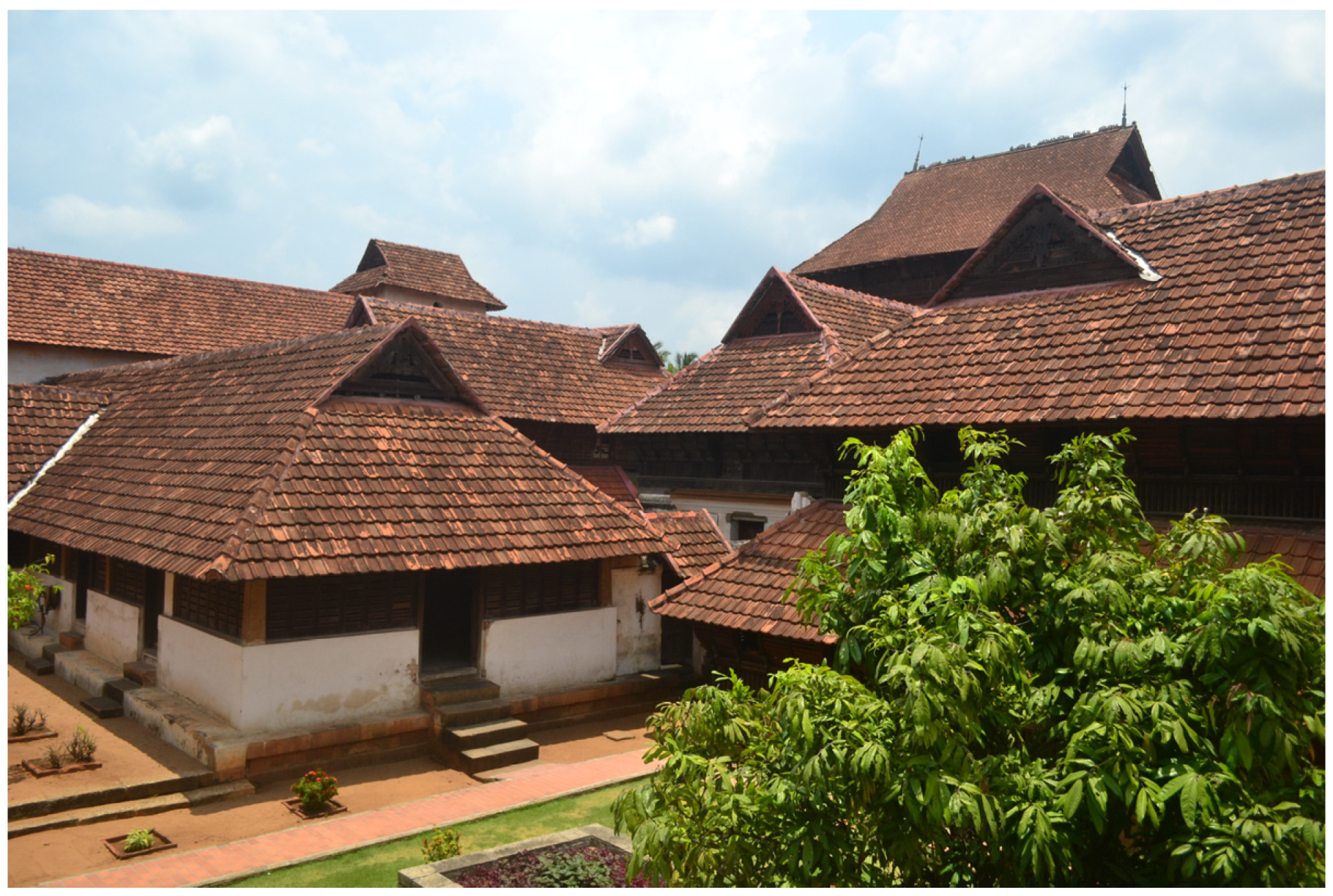

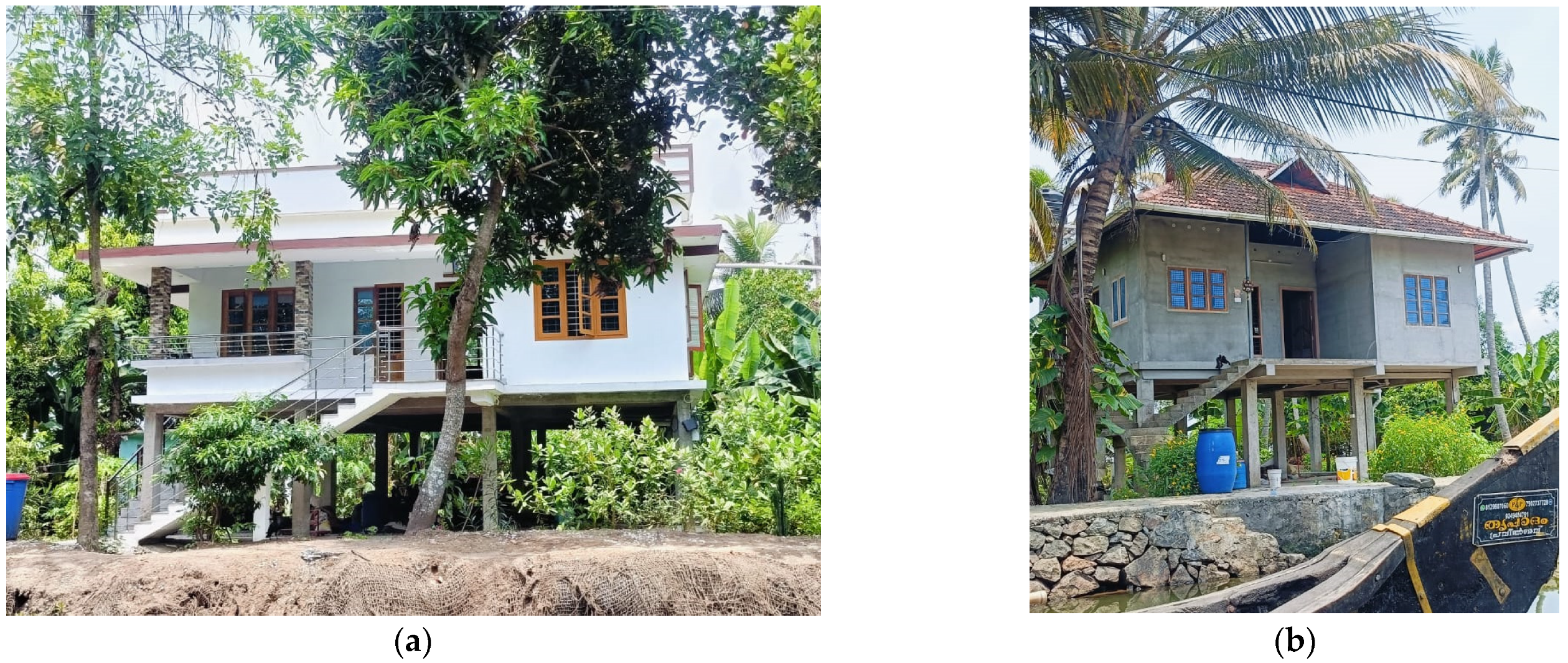
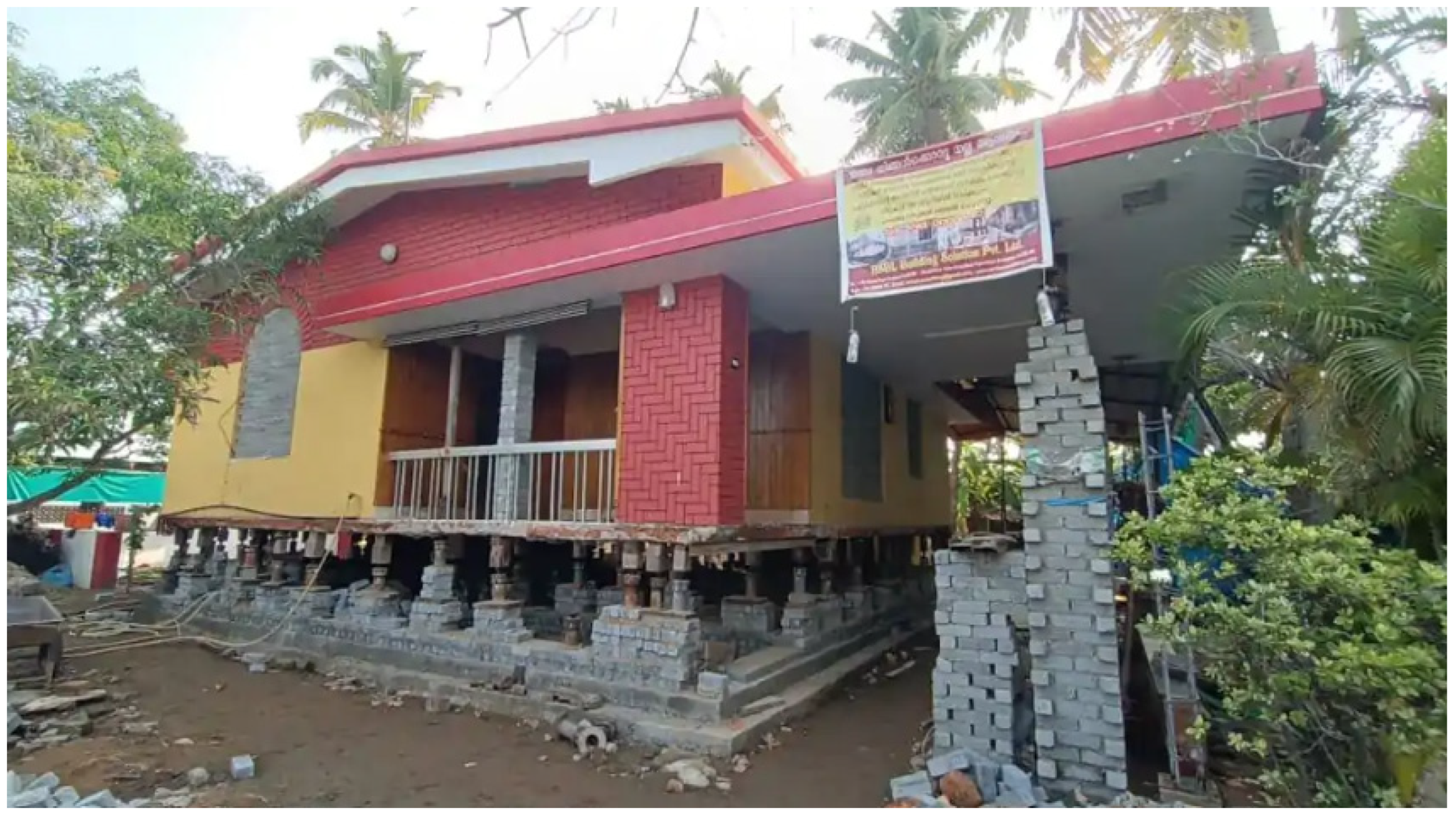

Disclaimer/Publisher’s Note: The statements, opinions and data contained in all publications are solely those of the individual author(s) and contributor(s) and not of MDPI and/or the editor(s). MDPI and/or the editor(s) disclaim responsibility for any injury to people or property resulting from any ideas, methods, instructions or products referred to in the content. |
© 2024 by the authors. Licensee MDPI, Basel, Switzerland. This article is an open access article distributed under the terms and conditions of the Creative Commons Attribution (CC BY) license (https://creativecommons.org/licenses/by/4.0/).
Share and Cite
Choorapulakkal, A.A.; Madandola, M.G.; Al-Kandari, A.; Furlan, R.; Bayram, G.; Mohamed, H.A.A. The Resilience of the Built Environment to Flooding: The Case of Alappuzha District in the South Indian State of Kerala. Sustainability 2024, 16, 5142. https://doi.org/10.3390/su16125142
Choorapulakkal AA, Madandola MG, Al-Kandari A, Furlan R, Bayram G, Mohamed HAA. The Resilience of the Built Environment to Flooding: The Case of Alappuzha District in the South Indian State of Kerala. Sustainability. 2024; 16(12):5142. https://doi.org/10.3390/su16125142
Chicago/Turabian StyleChoorapulakkal, Afeef Abdurahman, Muhammed Gbolahan Madandola, Amina Al-Kandari, Raffaello Furlan, Goze Bayram, and Hassan Abdelgadir Ahmed Mohamed. 2024. "The Resilience of the Built Environment to Flooding: The Case of Alappuzha District in the South Indian State of Kerala" Sustainability 16, no. 12: 5142. https://doi.org/10.3390/su16125142
APA StyleChoorapulakkal, A. A., Madandola, M. G., Al-Kandari, A., Furlan, R., Bayram, G., & Mohamed, H. A. A. (2024). The Resilience of the Built Environment to Flooding: The Case of Alappuzha District in the South Indian State of Kerala. Sustainability, 16(12), 5142. https://doi.org/10.3390/su16125142







